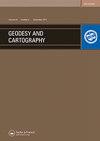从窗口看到的地理:用可视化工具定义地理特定视点图像的探索
IF 2.1
Q3 REMOTE SENSING
引用次数: 4
摘要
多媒体制图已经改变了地理探索的人工制品——从“冰冻景观”(用户不能改变的地理可视化)到“可塑可视化”(一种计算机生成的多媒体可视化,用户可以与之交互并“塑造”成最适合他们特定需求的可视化)。然而,有人认为,这引起了问题,因为多媒体制图更复杂。“看”的方式会影响认识的方式吗?交互式多媒体产品的应用真的能让人们获得“更好”的教育内容吗?使用新媒体技术进行地理教育最合适的教学方法是什么?人类是如何学习地理信息的,这种学习又是如何随着学习媒介(直接体验、地图、描述、虚拟系统等)的功能而变化的?本文报告了“地理探索馆”研究项目的初步发现,该项目调查了利用多媒体制图提供地理教学/学习元素的“不同方式”的构建和评估。“地理探索馆”通过提供不同的观点,提供了一种“看到”地理信息的新方式,希望确保“地理理解的空白”被从其他角度收集的信息所填补,并用于组装一个更完整的现实画面。本文章由计算机程序翻译,如有差异,请以英文原文为准。
Geography as seen from the Window: Explorations about Viewpoint-Specific Images of Geography Defined by Tools of Visualization
Multimedia Cartography has changed artifacts for geographical exploration-from ‘frozenscapes’ (visualizations of geography that cannot be altered by the user) to ‘Malleable Visualizations’ (a computer-generated multimedia visualization with which users can interact and ‘mold’ into one that best suits their particular needs). However, it is argued, this has caused problems, as Multimedia Cartography is more complex. Does the way of ‘seeing’ influence the way of knowing? Does the application of interactive multimedia products really allow access to ‘better’ educational packages? What is the most appropriate pedagogy for using New Media technologies for geography education? How do humans learn geographic information, and how does this learning vary as a function of the medium through which it occurs (direct experience, maps, descriptions, virtual systems, etc.)? This paper reports on the initial findings from the ‘GeoExploratorium’ research programme, that investigated the construction and evaluation of a ‘different way’ of offering geographical teaching/learning elements with multimedia cartography. The ‘GeoExploratorium’ provides a new way of ‘seeing’ geographical information by supplying different viewpoints, hopefully, ensuring that the ‘voids of geographical understanding’ are filled with information gathered from other perspectives and used to assemble a more complete picture of reality.
求助全文
通过发布文献求助,成功后即可免费获取论文全文。
去求助
来源期刊

Geodesy and Cartography
REMOTE SENSING-
CiteScore
1.50
自引率
0.00%
发文量
0
审稿时长
15 weeks
期刊介绍:
THE JOURNAL IS DESIGNED FOR PUBLISHING PAPERS CONCERNING THE FOLLOWING FIELDS OF RESEARCH: •study, establishment and improvement of the geodesy and mapping technologies, •establishing and improving the geodetic networks, •theoretical and practical principles of developing standards for geodetic measurements, •mathematical treatment of the geodetic and photogrammetric measurements, •controlling and application of the permanent GPS stations, •study and measurements of Earth’s figure and parameters of the gravity field, •study and development the geoid models,
 求助内容:
求助内容: 应助结果提醒方式:
应助结果提醒方式:


